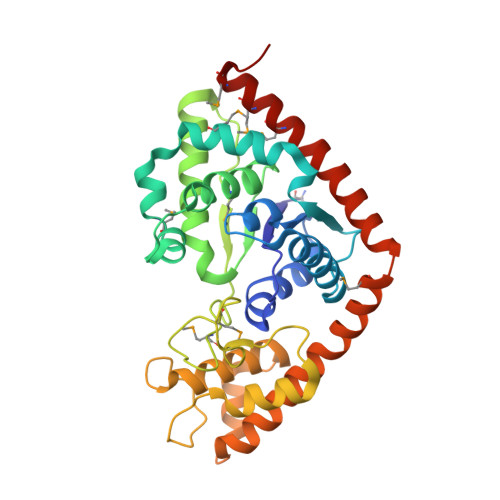High-resolution experimental phases for tryptophanyl-tRNA synthetase (TrpRS) complexed with tryptophanyl-5'AMP.
Retailleau, P., Yin, Y., Hu, M., Roach, J., Bricogne, G., Vonrhein, C., Roversi, P., Blanc, E., Sweet, R.M., Carter, C.W.(2001) Acta Crystallogr D Biol Crystallogr 57: 1595-1608
- PubMed: 11679724
- DOI: https://doi.org/10.1107/s090744490101215x
- Primary Citation of Related Structures:
1I6K, 1I6L, 1I6M - PubMed Abstract:
Native data, anomalous data at three wavelengths and an independent peak-wavelength data set for SeMet-substituted protein have been collected from cryoprotected crystals of the TrpRS-adenylate product (TAM) complex to a resolution limit of 1.7 A. Independent phase sets were developed using SHARP and improved by solvent flipping with SOLOMON using molecular envelopes derived from experimental densities for, respectively, peak-wavelength SAD data from four different crystals, MAD data and their M(S)IRAS combinations with native data. Hendrickson-Lattman phase-probability coefficients from each phase set were used in BUSTER to drive maximum-likelihood refinements of well defined parts of the previously refined room-temperature 2.9 A structure. Maximum-entropy completion followed by manual rebuilding was then used to generate a model for the missing segments, bound ligand and solvent molecules. Surprisingly, peak-wavelength SAD experiments produced the smallest phase errors relative to the refined structures. Selenomethionylated models deviate from one another by 0.25 A and from the native model by 0.38 A, but all have r.m.s. deviations of approximately 1.0 A from the 2.9 A model. Difference Fourier calculations between amplitudes from the 300 K experiment and the new amplitudes at 100 K using 1.7 A model phases show no significant structural changes arising from temperature variation or addition of cryoprotectant. The main differences between low- and high-resolution structures arise from correcting side-chain rotamers in the core of the protein as well as on the surface. These changes improve various structure-validation criteria.
Organizational Affiliation:
Department of Biochemistry and Biophysics, CB# 7260, University of North Carolina at Chapel Hill, Chapel Hill, NC, USA.



















